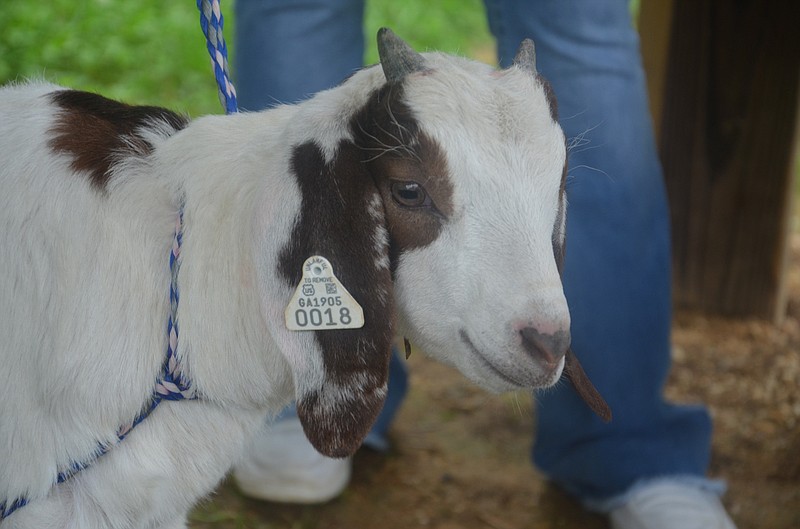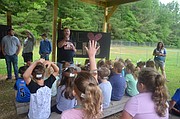Tethered and out of their pens for the first time, Marshmallow and Daisy seemed a little leery as a class of kindergarteners filed through the grass into the new outdoor classroom at North LaFayette Elementary School. These two baby goats, just a couple of months old, were about to meet a gaggle of new friends.
The children bubbled with excitement. In twice-weekly Google Meets, they had watched their adopted white-and-brown Boer goats grow almost since birth. This was the first face-to-face meeting, and the communal urge for pets and cuddles was palpable.
The human kids giggled and wiggled on wooden benches. Michael Gardner paced the grass in front of them under a new metal-roofed structure that is the result of the community's investment in its school.
Gardner is an award-winning agriculture education instructor at LaFayette High School. With the friendly excitement of a man adept at herding kindergarteners, he led a discussion on goat heart rates.
"Just like your heart, Daisy's heart beats about 80 times per minute," he told the children.
After a quick demonstration with a blue-tubed stethoscope, he broke the class into groups and set them loose.
One class at a time, 75 students from four kindergarten classes met Marshmallow, Daisy and two other goats that morning. Gardner's high school students handled the goats and helped waves of 5- and 6-year-olds listen to the animals' hearts. With all the petting and cuddling, it's a wonder the goats left with any fur at all.
It was the culmination of a project hatched this spring when veteran North LaFayette Elementary kindergarten teacher April Chambers acted on her dream to have a goat at school.
"She was asking all about what it would take to raise goats at the elementary school," Gardner said of his first meeting with Chambers. "Since they're not really equipped right now, we settled on them adopting a goat."
With a blessing from administrators, they selected a pregnant female named Freeya from the high school flock. When Freeya birthed twins over spring break, the kindergartners returned to school with the duty of naming two newborn goats.
"They learn love and compassion from caring for animals. They get excited about it," Chambers said. "It's enrichment and education beyond the classroom. It offers them the chance to learn where they're not even aware they're learning."
Gardner's Tuesday and Friday presentations from the goat barn were shown live on whiteboards in classrooms and on the computers of virtual students. In 20-minute classes, the children learned the basics of what a baby goat needs and watched as high school students trimmed hooves, injected vaccines and charted growth. Every class ended with a question-and-answer session.
"We got some funny questions like, 'Do goats eat tin cans?'" Gardner said. "But you could also tell there was a genuine interest in what they were seeing and learning."
Beyond science and biology, Chambers also channeled the goat energy into math, social studies and language arts lessons. The kids graphed and compared the goats' weight gain. They nominated and voted on names. They learned to research and wrote nonfiction stories about their goats.
Gardner said it was also a good experience for his students. While learning to care for livestock, they also learned to teach others, which fits into the leadership aspect of his curriculum.
This goat project is a prime example of the value of agricultural education for any age group. It accompanies a statewide push by Georgia's Department of Education to bring the subject into elementary schools. In 2018, the Georgia state Legislature passed the Green Agricultural Education Act, which launched a pilot program to introduce agricultural education into elementary schools.
In Walker County, Saddle Ridge School in Rock Spring is one of 26 Georgia schools participating in the three-year pilot to develop a statewide curriculum for agriculture education in elementary schools.
Gardner said there is tremendous support for agriculture education in Walker County Schools, and that goes right down to the local level, where NLE Principal David Schwind and LHS Principal Maggie Stultz were on board with the goat project from the get-go.
Neither principal missed the opportunity to show up and pet Marshmallow and Daisy.
Contact Nick Carter at nsc8957@gmail.com.

